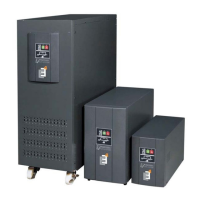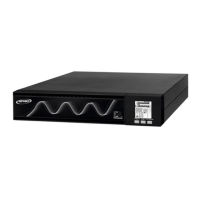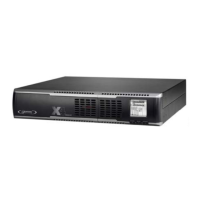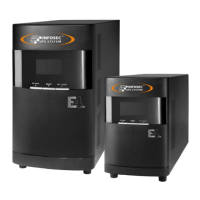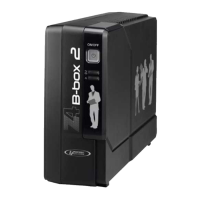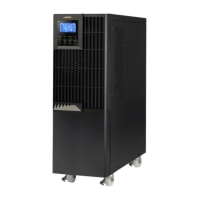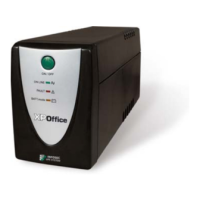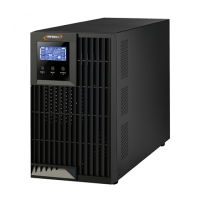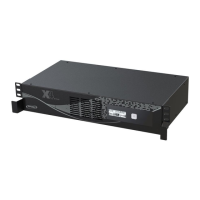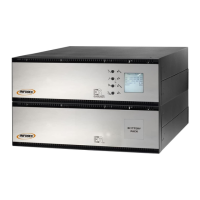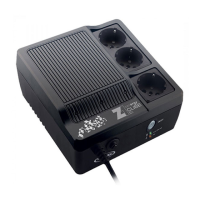Do you have a question about the INFOSEC M4T and is the answer not in the manual?
Instructions on how to use the manual and its purpose for installation and operation.
Explains warning, electrical discharge, earthing, and information symbols used in the manual.
Provides contact information for further assistance and help from the Service and Technical Support Department.
Emphasizes the importance of safety instructions and legal obligations for the user regarding safety.
Details conformity with EN ISO 9001 and EEC directives for low voltage and electromagnetic compatibility.
Information on proper disposal of UPS devices and batteries at the end of their useful life.
Shows cabinet front views for UPS devices up to 20kVA and from 30 to 80kVA with front doors closed.
Illustrates the control panel and detailed cabinet views with connection terminals.
Displays front views of battery cabinets (No. 1) with doors closed and opened.
Shows front views of the No. 2 battery cabinet with doors closed and opened.
Provides a comprehensive list and explanation of components, connecting elements, keyboard functions, and abbreviations used in diagrams.
Explains the block diagrams of M4T and M4T-B UPS models showing operating flow and critical safety notes.
Describes the normal operation where the rectifier converts AC to DC and supplies the inverter.
Explains how the UPS operates when mains power fails, relying on batteries.
Details operation when the inverter is inactive due to alarms or shutdown, using the bypass line.
Covers operation during maintenance using the manual bypass switch, isolating the UPS.
Crucial safety guidelines for installation, including earthing, handling precautions, and warning labels.
Specific safety instructions for handling, connecting, and risks associated with batteries during installation.
Instructions on how to access internal components and communication ports by unlocking the cabinet door.
Details on electrical connections, cable sections, protections, and safety precautions for internal battery configurations.
Procedures for receiving, inspecting for damage, and checking the contents of the UPS equipment upon delivery.
Guidelines for storing the UPS and battery packs in suitable conditions to maintain their integrity.
Advice on safely transporting the UPS and selecting an appropriate installation location, considering clearance and ventilation.
Instructions for connecting the mains power supply to the UPS input terminals, including safety warnings and backfeed protection.
Details on connecting the static bypass line for M4T-B versions, including safety and backfeed protection.
Guidance on connecting output cables to terminals for supplying loads, including three-phase output considerations.
Instructions for connecting the UPS to battery packs, emphasizing safety and correct wiring.
Explains the importance and connection of protective earth terminals for safety and power quality.
Describes communication ports for relay signaling and RS-232/RS-485 data, including pin-outs and usage.
Instructions for connecting external Emergency Power Off (EPO) terminals for immediate system shutdown.
Comprehensive guide for safely starting the UPS, including pre-checks, control panel operations, and handling alarms.
Explains the meaning of LED indicators on the control panel during operation.
Step-by-step instructions for safely shutting down the UPS system and all its components.
Explains how the Emergency Power Off function works and how to return the system to normal mode.
Detailed procedure for transferring the UPS operation to the maintenance bypass mode.
Steps to return the UPS from maintenance bypass back to normal, protected operation.
Identifies and describes the components of the control panel, including LEDs, display, and keys.
Explains the fundamental navigation and operation of the control panel keyboard.
Details how to navigate through menus and submenus on the LCD display.
Describes the initial main presentation screen and its submenus for UPS status and configuration.
Explains the screens related to unit control, status, start-up, shutdown, and battery testing.
Provides detailed descriptions for each measure screen (2.1 to 2.34), explaining the parameters displayed.
Explains how to configure various parameters like clock, language, communication settings, and automatic battery tests.
Describes how to view active alarms and lists common alarm messages displayed on the LCD screen.
Provides a comprehensive list of LCD screen alarms, their corresponding references, and brief descriptions.
Explains the data logger function, including inverter runtime, alarm history, and event logging.
Details the configuration menu, requiring a password to adjust advanced parameters.
Displays screens showing rated values for input, output, DC bus, battery charging, and voltage margins.
General guide for basic maintenance tasks, including battery, fan, and capacitor replacement, and safety precautions.
Specific instructions for replacing battery fuses and warnings about incorrect replacement.
Information on battery lifetime, testing, and risks of improper handling or disposal.
Notes on fan and capacitor lifetime and the recommendation for preventive replacement by authorized staff.
Outlines the limited warranty conditions and exclusions for the M4T series products.
Provides detailed technical specifications for the UPS models, including input, inverter, bypass, and general parameters.
Defines common technical terms and acronyms used in the manual, such as AC, DC, Bypass, IGBT, and Rectifier.
General safety instructions and recommendations for installation, operation, and compliance with local standards.
Crucial safety guidelines for electrical connections, handling live parts, earthing, and cable selection.
Specific safety interactions and precautions for UPS systems equipped with batteries, including handling and connection.
Detailed safety instructions for handling batteries, covering short-circuiting, disposal, and chemical risks.
